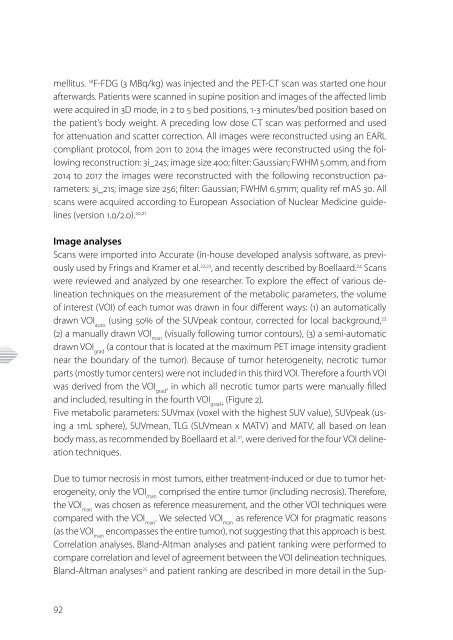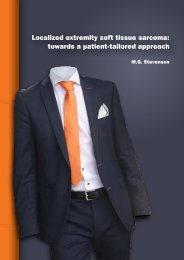Stevenson boek digi
Create successful ePaper yourself
Turn your PDF publications into a flip-book with our unique Google optimized e-Paper software.
5. Volume of interest delineation techniques for 18 F-FDG PET-CT scans<br />
mellitus. 18 F-FDG (3 MBq/kg) was injected and the PET-CT scan was started one hour<br />
afterwards. Patients were scanned in supine position and images of the affected limb<br />
were acquired in 3D mode, in 2 to 5 bed positions, 1-3 minutes/bed position based on<br />
the patient’s body weight. A preceding low dose CT scan was performed and used<br />
for attenuation and scatter correction. All images were reconstructed using an EARL<br />
compliant protocol, from 2011 to 2014 the images were reconstructed using the following<br />
reconstruction: 3i_24s; image size 400; filter: Gaussian; FWHM 5.0mm, and from<br />
2014 to 2017 the images were reconstructed with the following reconstruction parameters:<br />
3i_21s; image size 256; filter: Gaussian; FWHM 6.5mm; quality ref mAS 30. All<br />
scans were acquired according to European Association of Nuclear Medicine guidelines<br />
(version 1.0/2.0). 20,21<br />
Image analyses<br />
Scans were imported into Accurate (in-house developed analysis software, as previously<br />
used by Frings and Kramer et al. 22,23 , and recently described by Boellaard. 24 Scans<br />
were reviewed and analyzed by one researcher. To explore the effect of various delineation<br />
techniques on the measurement of the metabolic parameters, the volume<br />
of interest (VOI) of each tumor was drawn in four different ways: (1) an automatically<br />
drawn VOI auto<br />
(using 50% of the SUVpeak contour, corrected for local background, 22<br />
(2) a manually drawn VOI man<br />
(visually following tumor contours), (3) a semi-automatic<br />
drawn VOI grad<br />
(a contour that is located at the maximum PET image intensity gradient<br />
near the boundary of the tumor). Because of tumor heterogeneity, necrotic tumor<br />
parts (mostly tumor centers) were not included in this third VOI. Therefore a fourth VOI<br />
was derived from the VOI grad<br />
, in which all necrotic tumor parts were manually filled<br />
and included, resulting in the fourth VOI grad+<br />
(Figure 2).<br />
Five metabolic parameters: SUVmax (voxel with the highest SUV value), SUVpeak (using<br />
a 1mL sphere), SUVmean, TLG (SUVmean x MATV) and MATV, all based on lean<br />
body mass, as recommended by Boellaard et al. 21 , were derived for the four VOI delineation<br />
techniques.<br />
Due to tumor necrosis in most tumors, either treatment-induced or due to tumor heterogeneity,<br />
only the VOI man<br />
comprised the entire tumor (including necrosis). Therefore,<br />
the VOI man<br />
was chosen as reference measurement, and the other VOI techniques were<br />
compared with the VOI man<br />
. We selected VOI man<br />
as reference VOI for pragmatic reasons<br />
(as the VOI man<br />
encompasses the entire tumor), not suggesting that this approach is best.<br />
Correlation analyses, Bland-Altman analyses and patient ranking were performed to<br />
compare correlation and level of agreement between the VOI delineation techniques.<br />
Bland-Altman analyses 25 and patient ranking are described in more detail in the Sup-<br />
Figure 2. An example illustrating the differences in tumor delineation between the four VOI delineation<br />
techniques, for patient 4 scan 2.<br />
A VOI auto<br />
B VOI man<br />
C VOI grad<br />
D VOI grad+<br />
plemental Methods. Changes in metabolic tumor activity during neoadjuvant treatment<br />
were measured using the five metabolic parameters obtained from the reference<br />
VOI man<br />
and were related to histopathologic responses. Histopathologic tumor<br />
responses were established in accordance with the European Organization for Research<br />
and Treatment of Cancer-Soft Tissue and Bone Sarcoma Group (EORTC-STBSG)<br />
STS response score. 19 Grade A representing no stainable tumor cells; Grade B, single<br />
stainable tumor cells or small clusters (overall below 1% of the whole specimen);<br />
Grade C, ≥1%-



